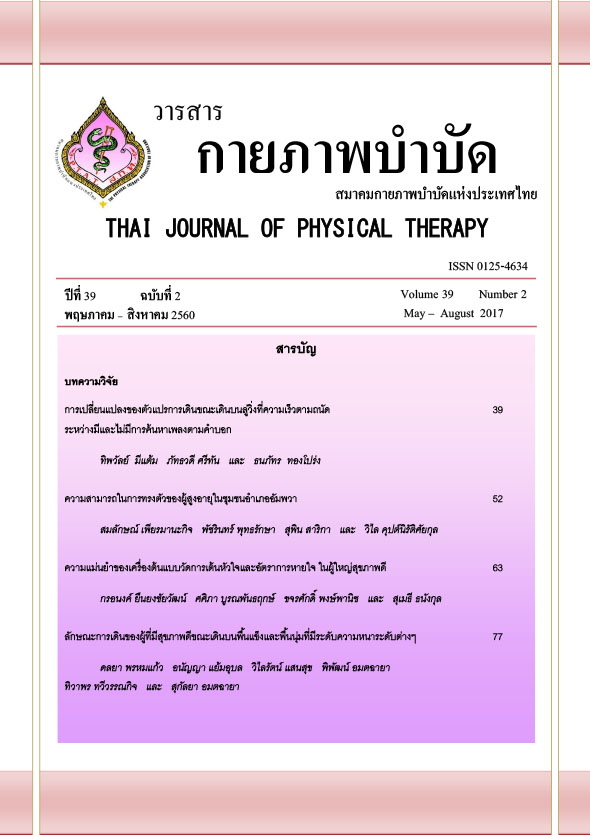Gait characteristics of healthy individuals while walking on hard and soft surfaces with different levels of thickness
Main Article Content
Abstract
Background: Soft surfaces provide unstable areas that challenge walking ability. However, no existing evidence reported the effects of soft surfaces and level of thickness affecting walking characteristics.
Objectives: Investigated walking characteristics of 16 healthy subjects while walking on soft surfaces with 1inch and 3inches thickness as compared to a hard surface.
Methods: Subjects (average age 26±2.85years) were assessed for their walking speed, cadence, stride length and step symmetry while walking over each surface at a self-selected and fastest speed for 3 trials/surface. During walking, the researchers recorded walking characteristics of the subjects for further two-dimensional analysis using the Kinovea program. Then the ANOVA with repeated measure was used to compare average findings of all parameters while walking on each surface. The levels of significant differences was set at p<0.05.
Results: Subjects walked on soft surface with a significantly slower speed and cadence than on a hard surface both preferred and fastest speed (walking speed = 1.12-1.35m/s and 1.34-1.74m/s, cadence = 96-110 steps/min and 120-139 steps/min for soft and hard surfaces when walked at a prefer and fastest speed, respectively, p<0.05). However, there were no significant differences of other variables, and between 1inch and 3inches thickness soft surfaces (p>0.05).
Conclusion: Walking on soft surfaces challenge walking ability, especially in temporal parameters. However, a soft surface with 1inch thickness may be more suitable for clinical application than the 3inches thickness because it is lighter, cheaper and easier to be moved and storage than 3inches thickness soft surface. However, the findings are preliminary data in healthy subjects. Thus, a further study should investigate in subjects with movement impairments to confirm the application of soft surfaces in clinical rehabilitation.
Article Details
References
2. Sawachaa Z, Spolaora F, Guarnerib G, et al. Abnormal muscle activation during gait in diabetes patients with and without neuropathy. Gait Posture 2012; 35: 101-5.
3. Boonstra TA, van der Kooij H, Munneke M, Bloem BR. Gait disorders and balance disturbances in Parkinson's disease: clinical update and pathophysiology. CurrOpinNeurol 2008; 21: 461-71.
4. Behrman A, Harkema S. Locomotor training after human spinal cord injury: a series of case studies. Phys Ther 2000; 80: 688-700.
5. Amatachaya S, Kaewsutthi M. Gait rehabilitation for patients with incomplete spinal cord injury (iSCI): conventional and treadmill training. J Med Tech Phys Ther 2007; 19: 7-19.
6. Behrman AL, Bowden MG, Nair PM. Neuroplasticity after spinal cord injury and training: an emerging paradigm shift in rehabilitation and walking recovery. Phys Ther 2006; 86: 1406-25.
7. Morrison K, Braham RA, Dawson B, Guelfi K. Effect of a sand or firm-surface walking program on health, strength, and fitness in women 60-75 years old. J Aging Phys Act 2009; 17: 196-209.
8. Pinnington HC, Dawson B. The energy cost of running on grass compared to soft dry beach sand. J Sci Med Sport 2001; 4: 416-30.
9. Lejeune TM, Willems PA, Heglund NC. Mechanics and energetics of human locomotion on sand. J ExpBiol 1998; 201: 2071-80.
10. National Spinal Cord Injury Statistical Center. Spinal cord injury facts and figures at a glance. J Spinal Cord Med 2013; 36: 568-9.
11. Cardenas DD, Hoffman JM, Kirshblum S, McKinley W. Etiology and incidence of rehospitalization after traumatic spinal cord injury: a multicenter analysis. Arch Phys Med Rehabil 2004; 85: 1757-63.
12. Pramodhyakul N, Amatachaya P, Sooknuan T, Arayawichanon P, Amatachaya S. Visuotemporal cues clinically improved walking ability of ambulatory patients with spinal cord injury within 5 days. J Spinal Cord Med 2016; 39:405-11.
13. Kumprou M, Amatachaya P, Sooknuan T, Thaweewannakij T, Mato L, Amatachaya S.Do ambulatory patients with spinal cord injury walk symmetrically? Spinal Cord 2016; 55; 204-7.
14. Kumprou M, Amatachaya P, Sooknuan T, Thaweewannakij T, Amatachaya S. Is walking symmetry important for ambulatory patients with spinal cord injury? Disabil Rehabil 2017; 1-9
15. Kirtley C. Clinical gait analysis: theory and practice. Edinburgh: Livingstone; 2006.
16. Balasubramanian CK, Bowden MG, Neptune RR, Kautz SA. Relationship between step length asymmetry and walking performance in subjects with chronic hemiparesis. Arch Phys Med Rehabil 2007; 88: 43-9.
17. Patterson KK, Gage WH, Brooks D, Black SE, McIlroy WE. Evaluation of gait symmetry after stroke: a comparison of current methods and recommendations for standardization. Gait Posture 2010; 31: 241-6.

